AI Tutors in Higher Education: The Complete Institutional Guide (2025)

In the education technology landscape, we know AI tutor solutions are everywhere - ranging from AI chatbots to AI-driven quiz generators - but most aren’t built for the complexity of higher education. From ensuring student data privacy to safeguarding academic integrity, institutions today need more than a chatbot. Higher education is charting new territory: how to integrate AI tutor solutions into the everyday lives of students? How to ensure these edtech tools meet the highest safety and privacy standards, while maintaining high pedagogical integrity and learning standards?
This guide will walk you through 10 sections, unpacking what it takes to adopt AI tutor solutions that truly support learning - securely, ethically, and effectively - while supporting students in their diverse learning journeys, at every step of the way.
First, the guide will expand upon what an AI Tutor is (and what it isn’t). Next, you will learn about a few top use cases for AI tutoring in higher education, followed by a comparison of solutions in the current education technology market. The guide will cover the difference between AI Feedback (for educators) and AI Tutoring (for students), and use cases by role. The final sections cover ethics in edtech applications focusing on tutoring for students, including guardrails, governance, and opt-in design. Lastly, the guide offers a platform comparison to popular platforms such as ChatGPT, Khanmigo, and Mindgrasp, concluding with a short vendor checklist educational leaders can follow before choosing to pilot an AI Tutor at their institution.
Chapter 1: What Is an AI Tutor (And What Isn’t)
AI tutors are rapidly emerging across the education landscape, but most tools marketed as “AI tutors” today fall into one of two extremes:
- Lightweight chatbot experiences that lack academic context or depth
- Overly complex AI models that are difficult to govern or integrate into institutional workflows
For higher education, the bar is higher. An AI tutor must do more than chat. It should engage with academic content, align with teaching practices, and integrate seamlessly into your digital learning ecosystem.
Characteristics of an AI Tutor built for Higher Education:
- LMS/VLE-integrated, not just embedded or external
- Supports personalized, course-based learning, not generic Q&A flows
- Respects data privacy (FERPA/GDPR) and academic integrity
- Augments, not replaces, human instruction
- Offers transparent prompt design, analytics, and institutional control
Think of it not as “ChatGPT with a syllabus,” but as a course-aware learning companion that supports student understanding within trusted academic boundaries.
What It’s Not:
- A consumer chatbot retrofitted for education
- A tool that pulls from unknown sources or crowdsourced content
- A one-size-fits-all agent with no role or policy awareness
- An invisible layer with no faculty control or auditability
This foundational understanding is essential to help institutions select tools that align with pedagogy, privacy, and practicality, not just novelty.
Bottom line: AI Tutor tools are built with pedagogical principles in mind.
Designing AI feedback systems that enhance teaching and learning without compromising academic integrity are key. When implemented thoughtfully, AI Tutor tools can provide personalized guidance at scale, foster deeper learning pathways, and increase student engagement. But without clear boundaries, these same tools risk eroding student trust, introducing bias, or enabling shortcuts that undermine authentic learning.
So how do you design an AI tutoring solution that’s not just smart, but also ethical, transparent, and aligned with academic values?
Traditional educational models often struggle to cater to the diverse needs of individual learners. Students may have different learning styles, paces, and levels of prior knowledge. One-size-fits-all approaches can leave some students behind while failing to challenge others - leaving some of them feeling like they have failed, resulting in a lack of student engagement and motivation.
The solution is building an AI tutoring assistant that leverages the power of personalization, active learning, and cognitive load management to create a more engaging and effective learning environment. Aligning product design with these pillars in mind is intentional - they are foundational pedagogical approaches to effective learning, backed by research, and particularly well-suited to be enhanced by AI.
Here, we will focus on three key pedagogical concepts:
- Personalized Learning: Tailoring instruction to meet individual student needs, preferences, and goals.
- Active Learning & Retrieval Practice: Engaging students in activities that require them to actively process and recall information with an element of gamification, appealing to a wider audience within the student body. A huge trend across industries - and the ed tech world - aligns with student expectations of active learning, not only within the classroom but outside of it.
- Cognitive Load Management: Optimizing the mental effort required for learning by minimizing distractions and streamlining information access.
Examinons-les un par un :
1. L'apprentissage personnalisé : Le parcours unique de chaque élève
What it is: Personalized learning recognizes that each student has a unique combination of strengths, weaknesses, learning styles, and goals. Personalized learning moves away from a standardized approach to education and instead focuses on tailoring the learning experience to meet individual needs.
This can involve adjusting the pace of instruction, the content type presented, and assessment methods (Bray & McClaskey, 2015). The concept draws heavily on constructivist learning theory, which posits that learners actively construct their own knowledge and understanding based on their experiences and interactions (Piaget, 1954).
L'approche LearnWise pour l'apprentissage personnalisé :
- User Recognition: The platform provides personalized support by identifying critical user data and tailoring responses based on the learner's history and preferences. This creates a more intuitive and relevant learning experience
- Personalized Learning Path: Students are often made aware of their pitfalls through feedback from instructors, peer review as well as formative and summative assessments, yet they are rarely equipped to take action. Our AI assistant allows students to create flashcards, review and be quizzed on specific content they find challenging, or delve deeper in their topics of interest.
- Personalized Assistance: The ability to create a customized study plan for a specific course enhances time management, providing students with a realistic roadmap while reducing the burden on instructors to address each student's individual needs. LearnWise acts as a virtual tutor, supporting personalized learning journeys.
Impact: By providing a customized learning experience, LearnWise helps students feel seen, supported, and empowered. This leads to an increased motivation, engagement, and ultimately, better learning outcomes for students.
2. Apprentissage actif et pratique de la récupération : Engager l'esprit pour une compréhension plus profonde
What it is: Active learning encompasses any instructional method that engages students in the learning process, requiring them to do meaningful learning activities and think about what they are doing (Prince, 2004). A key component of active learning is retrieval practice, also known as active recall. This involves actively retrieving information from memory, which has been shown to significantly improve long-term retention and comprehension compared to passive study methods like re-reading (Karpicke & Roediger, 2008).
The LearnWise Approach to Active Learning:
Study Plans and Practice Quizzes: The AI Tutor generates personalized study plans and practice quizzes that encourage students to actively engage with the material and retrieve information from memory. These quizzes are not just for assessment; they are designed as learning tools to help students identify knowledge gaps and reinforce understanding. The tool is also able to develop flashcards, helping student exercise long-term retention and comprehension.
Gamification: AI Tutor solutions encourage students to play with course content materials, by tailoring the type of questions for quizzing, shuffling their order, or having to answer correctly before moving on to the next question, making the study process less cumbersome and repetitive for students.
Self-Quiz Generation: Students can use AI Tutor to generate personalized quizzes from course materials, further promoting active recall and retrieval practice. This empowers students to take a more active role in their learning and assess their understanding of the material.
Instant Course-Specific Inquiries: AI Tutors provide immediate answers about grades, timelines, agendas, and more, allowing students to quickly clarify any doubts and actively engage with course content.
24/7 Availability: Students can ask questions and receive explanations at anytime, encouraging them to actively seek clarification and engage with the material whenever they encounter challenges.
Impact: By promoting active learning and retrieval practice, LearnWise helps students move beyond surface-level understanding and develop a deeper, more durable grasp of the subject matter.
3. Gestion de la charge cognitive : Ouvrir la voie à l'apprentissage
What it is: Cognitive Load Theory (CLT) is concerned with the limitations of working memory. It suggests our working memory has a limited capacity, and effective instruction should be designed to minimize extraneous cognitive load (mental effort unrelated to learning) and optimize germane cognitive load (mental effort directly related to learning) (Sweller, 1988). Extraneous load can be caused by factors such as confusing instructions, poorly designed materials, or having to search for information across multiple sources.
The LearnWise Approach to Cognitive Load Management:
Unified Information Hub: LearnWise centralizes information from various sources, including the LMS, third-party apps, and external resources. This reduces the cognitive load associated with searching for information across multiple platforms, allowing students to focus their mental energy on learning.
Dynamic Content Updates: The platform adapts responses based on content changes, ensuring students always have the most up-to-date information. This eliminates the need to spend time and energy determining what content is current, further reducing cognitive load.
Streamlined Course Navigation Assistance: LearnWise helps students navigate their course structure and understand the syllabus, minimizing confusion and allowing them to focus on the content itself.
One Place, One Solution: students don't have to leave the platform even when they can't find the right answers. LearnWise is able to ask context-based suggested questions, follow up accordingly, and escalate students to the right department, massively reducing cognitive load.
Impact: By streamlining access to information and reducing cognitive load, AI Tutors free up students' mental resources for deeper learning and engagement with course content.
Chapter 2: Top Use Cases for AI Tutoring in Universities
Institutions are no longer asking if they should implement AI, but rather where to start. Facing time and budget constraints, education institutions feel the pressure to modernize support and personalize learning. In this scenario, AI tutoring is one of the most actionable, scalable use cases for institutions starting their AI adoption journey.
But to go beyond generic chatbots or external study apps, institutions must focus on AI tutoring use cases that are tied to real teaching and learning workflows.
This chapter outlines the most impactful applications of LMS-integrated, course-aware AI tutors, based on LearnWise partner institutions, EDUCAUSE research, and global adoption trends.
Why Focus on Tutoring?
In a 2025 study from EDUCAUSE, 68% of institutions piloting AI reported the greatest impact in scenarios tied to:
- Student self-regulation
- Assignment clarification
- Content review and reinforcement
These align perfectly with what AI tutors do best: offer scaffolded academic help at scale, without replacing faculty or rewriting curricula.
High-Impact AI Tutoring Use Cases
1. Context-Aware Q&A
AI tutors embedded in the LMS can respond to questions tied directly to:
- Course assignments
- Lecture slides or transcripts
- Rubrics and grading criteria
- Policy documents (e.g., late submissions, formatting rules)
Example query: “What does my professor mean by ‘critical synthesis’ in the essay instructions for Week 3?”
The AI responds by referencing the uploaded rubric and lecture notes, not external sources or assumptions. The result is a low risk in hallucinations while guaranteeing informational accuracy, delivering only vetted course materials and approved institutional knowledge.
As a result, this reduces the “fog of learning” for students and saves faculty time answering repeat questions.
2. Personalized Study Plans
AI can generate individualized study plans by:
- Pulling information available in the LMS, including deadlines
- Detecting difficulties with specific course material to developing a stronger, personalized plan tailored to each student need
- Adapting based on user input (e.g., “I can study 2 hours/day max”)
"Build me a study plan that covers readings for Psych 101, Stats 102, and English Lit, with time to review before Friday’s quiz.”
Unlike static calendars, this mode offers dynamic, multi-course workload planning, especially valuable for first-year students and neurodiverse learners.
3. Interactive Quiz & Flashcard Generation
Using the student’s course content, the AI tutor can:
- Generate multiple-choice questions
- Create fill-in-the-blank practice items
- Build flashcard decks from lecture notes or textbook chapters
- Integrate with interactive content such as H5P archives and learning materials
This enhances engagement and supports spaced retrieval, a proven learning technique.
LearnWise’s study tools align with course outcomes and Bloom’s taxonomy, allowing instructors to guide AI-generated content toward formative assessment goals.
4. Clarifying Lecture Recordings & Notes
Many students struggle to process or recall dense lecture content, especially in asynchronous, hybrid, or multilingual environments. AI tutors allow students to:
- Ask questions about lecture videos or notes
- Request summaries or examples
- Translate and simplify academic language
Example Query: “Summarize the key points from this week’s statistics lecture and give me one worked example.”
This use case supports inclusive learning and universal design by meeting students at their level of comprehension.
5. Policy and Deadline Information
AI tutors can cross-reference course policies to answer questions like:
- “Can I submit this lab late?”
- “Which of my courses allow one missed discussion post?”
- “What happens if I miss an assignment in Econ vs. Bio?”
This reduces anxiety, streamlines communication, and reinforces student agency.
6. Cross-Course Workload Management
Especially valuable in the final weeks of the term, AI can help students:
- Visualize due dates across all enrolled courses
- Flag potential conflicts or bottlenecks
- Suggest rebalancing options or time-blocking strategies
7. Support Routing & Resource Navigation
AI tutors can also act as a frontline triage agent, connecting students with institutional resources beyond the classroom:
- Library guides
- Accessibility services
- Mental health or well-being tools
- Technical support (e.g., “How do I upload a PDF to Canvas?”)
All routed through a single interface that understands user role, intent, and knowledge sources.
Why Use Cases Matter for Adoption
Most failed AI pilots in higher education don’t fail due to bad technology. They fail because use cases are:
- Too vague ("help students with AI")
- Too narrow (only administrative chatbots)
- Too disconnected from real workflows (not embedded in the LMS/VLE)
That’s why AI Tutors such as LearnWise’s emphasize practical, course-aligned use cases that meet users where they are, and grow with institutional maturity.
Use Case: Embedding AI Tutors to Surface Course Content and Library Knowledge with the University of Westminster
The University of Westminster, serving more than 20,000 students from over 140 countries, partnered with LearnWise to strengthen equity, access, and learning support through AI. The institution needed a solution that could handle diverse academic needs, 24/7 support, and reduce burden on staff, all while respecting the complexity of course content and institutional knowledge.
Using LearnWise, the university deployed two AI agents within their ecosystem:
- Liby, a library assistant trained on hundreds of LibGuides to help students discover and navigate library resources
- Maia, a course assistant embedded into their Blackboard LMS that answers student questions about assessments, deadlines, module content, and can generate practice quizzes on demand
Here’s how an AI tutor helped the University of Westminster support their students and their learning journeys:
- Stepwise implementation: Westminster began with a general help‑desk assistant, which then evolved into knowledge‑specific agents (library first, then course). The earlier helpdesk phase revealed students often didn’t just want tech help; they needed course‑level answers. This insight informed the shift toward embedding the AI Tutor directly in Blackboard.
- Course‑aware responses: Maia is able to answer queries such as “What’s the difference between assessment submission windows?” or “Can I submit this late?” within the context of the module rules and syllabus. It also generates student-facing quizzes aligned to course material.
- Insight into student behavior: Academic staff are able to see what questions students frequently ask, helping instructors identify misconceptions and content gaps that might need curriculum updates or supplemental explanation.
- Library integration: Liby helps students with research and resource discovery, taking otherwise “hidden” library guides and surfacing them via conversational AI.
- Early but promising outcomes: In the pilot window (March–June 2025), Westminster saw repeated queries about assessments, revision prompts, and deadline clarity. Student anecdotal feedback was positive, particularly praising Maia’s ability to simplify study preparation. Leadership is already discussing how to scale the tool to more modules, embed AI into support services (e.g. mental health, counseling), and centralize institutional knowledge management.
This case demonstrates how a carefully scoped, role‑aware AI tutor can bridge library and course domains, lighten repetitive support burdens, and surface real student learning needs, all while operating within the institution’s LMS and policies.
Chapter 3: Meet The Secure, Role-Aware AI Tutor Inside Your LMS
It’s not enough for an AI tutor to be smart. It needs to be secure, context-aware, and built to scale within your institution’s digital ecosystem. That’s where most consumer-facing AI tools fall short. They’re designed for individual productivity, not institutional trust.
LearnWise takes a fundamentally different approach.
It embeds AI tutoring directly within the LMS, configured for institutional control, role differentiation, and pedagogical alignment from day one.
Why Institutional Trust Requires More Than Features
Every time a student interacts with AI, they’re not just engaging with a tool, they’re engaging with an institution’s credibility. If the tutor provides incorrect information, contradicts policy, or breaches privacy, the consequences can compound very quickly. That’s why LearnWise prioritizes:
- Data privacy and compliance (GDPR, FERPA, ISO 27001)
- Role-based access control (RBAC)
- Institution-governed prompt behavior
- Source transparency and auditability
We treat AI tutoring as critical infrastructure, not experimental edtech.
What Makes LearnWise AI Tutors Different?
1. Deep LMS Integration
LearnWise is natively embedded in:
- Brightspace
- Canvas
- Moodle
- Blackboard
LearnWise works inside the learning workflow, pulling directly from:
- Assignments
- Rubrics
- Course pages
- Uploaded readings
- Video transcripts
- H5P Content
This allows for zero-friction access and real-time, course-aware support.
2. Role-Aware Architecture
Not all users are equal, and your AI shouldn’t treat them that way.
LearnWise recognizes and differentiates between:
- Les étudiants
- Instructors
- Advisors
- Support staff
- System admins
Each role has unique permissions, prompt behavior, and visibility. For example:
- Students can access AI study tools tied to their courses
- Instructors can review AI usage patterns and customize prompts
- Advisors can use the same system to escalate questions or flag risk
This ensures contextual support, appropriate AI boundaries, and user trust.
3. Policy-Aware Prompting
Every LearnWise interaction is governed by institutional rules, including:
- Approved knowledge sources
- Custom disclaimer language
- Privacy settings
- Accessibility accommodations
- Course-level opt-in controls
Instructors can:
- Edit or preview prompts
- Turn AI on/off per assignment
- Flag problematic AI responses for review
4. Built-in Auditing and Analytics
All AI interactions can be:
- Logged and reviewed by administrators
- Linked to specific users, courses, or roles
- Filtered by intent, topic, or query frequency
- Exported to your BI dashboard or data lake
Dashboards show:
- Time to resolution
- Self-service success rate
- Most accessed content
- Prompt effectiveness
- Instructor opt-in rates
5. Support for Multilingual Institutions
LearnWise offers AI tutoring in 107+ languages, with localization settings for:
- Input/output language preferences
- Course content in multiple languages
- Code-mixed language handling (e.g., Welsh-English, Dutch-English)
This is especially critical for international institutions where student populations are diverse.
A Practical Example: LearnWise AI Tutor in your LMS
Students using LMS such as Brightspace, Canvas or Moodle can access the AI Tutor directly from their familiar digital environment. While studying, they can receive better support by utilizing the AI Tutor to support their learning journey with personalized recommendations, such as lesson plans, time management advice and more based on the learner’s history and preferences.
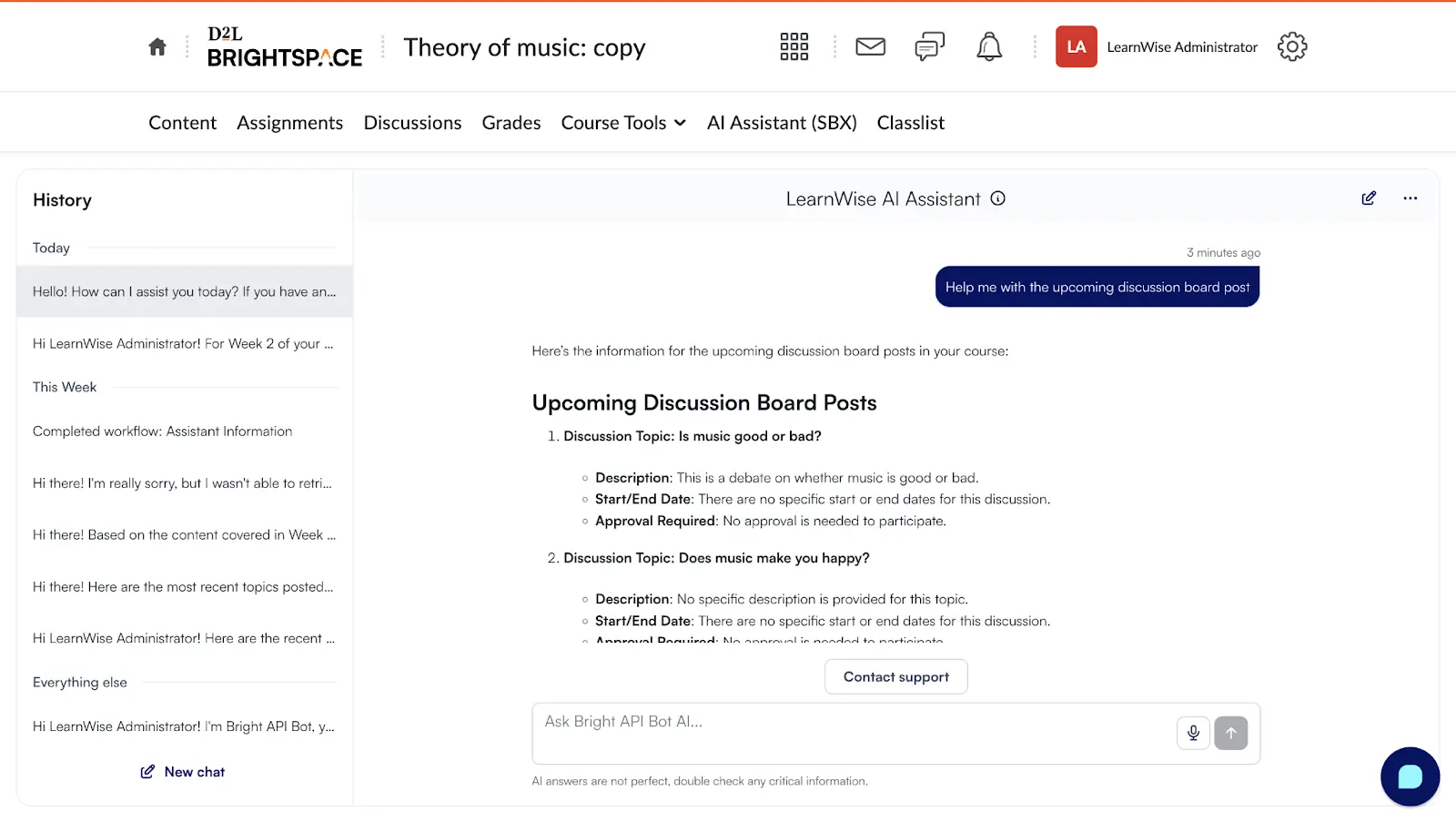
Solutions like the AI Tutor help enable deeper learning by creating practice quizzes, flashcards, role play exercises and multiple choices based on course content with the ‘Study Mode’ or via H5P interactives.
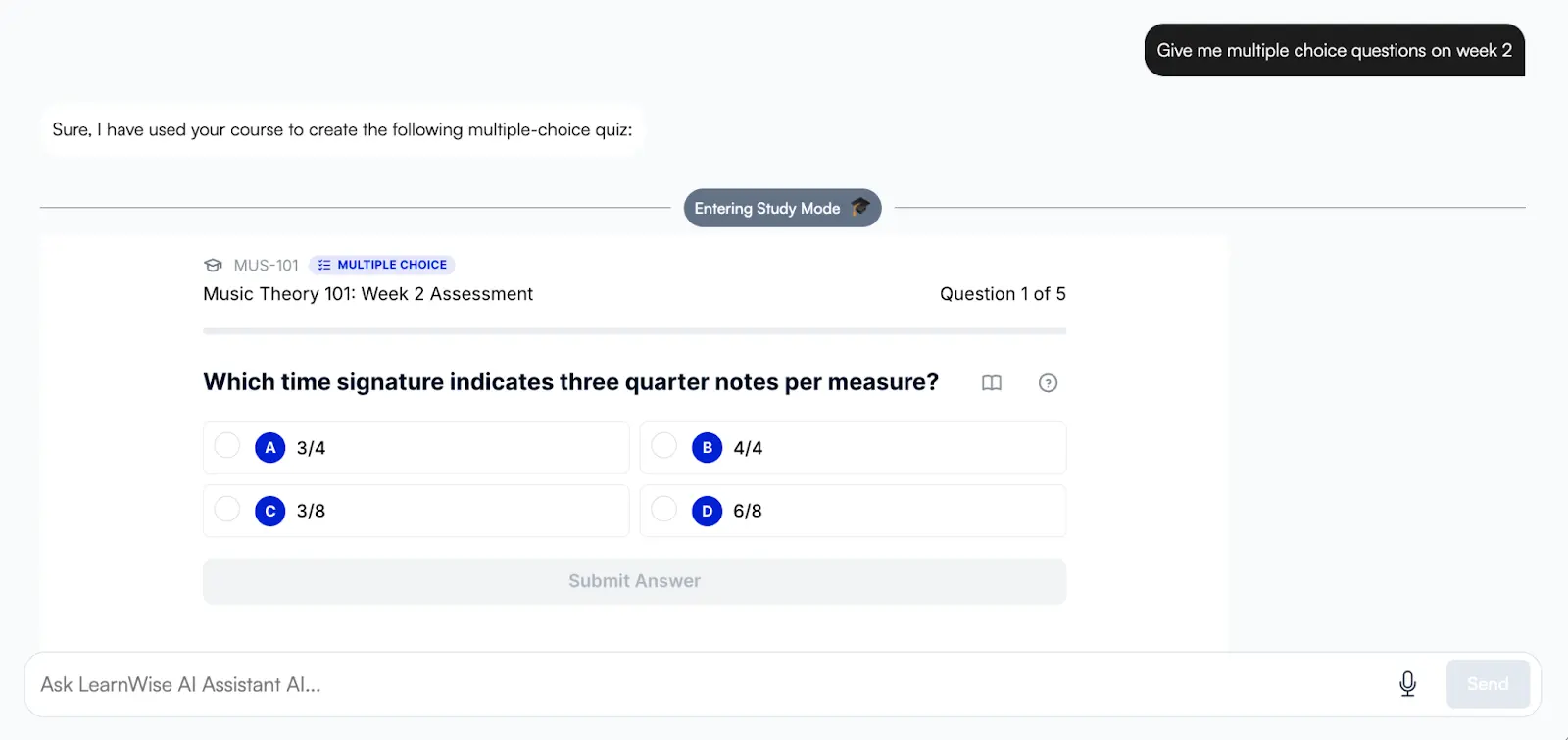
With the AI Tutor, Instructors can use insights to identify key trends and topics students struggle with, helping faculty track metrics like the AI Resolution Rate to improve upon course content with data-driven decisions.
The insights dashboard enables teachers to review student interactions with the tool, helping them identify pain points or challenging material. The tutor module supports students in parallel, generating pre-assignment checklists, study tips, and clarification of grading expectations.
This dual-mode support ensures that both students and faculty benefit, without leaving the LMS.
Télécharger l'étude


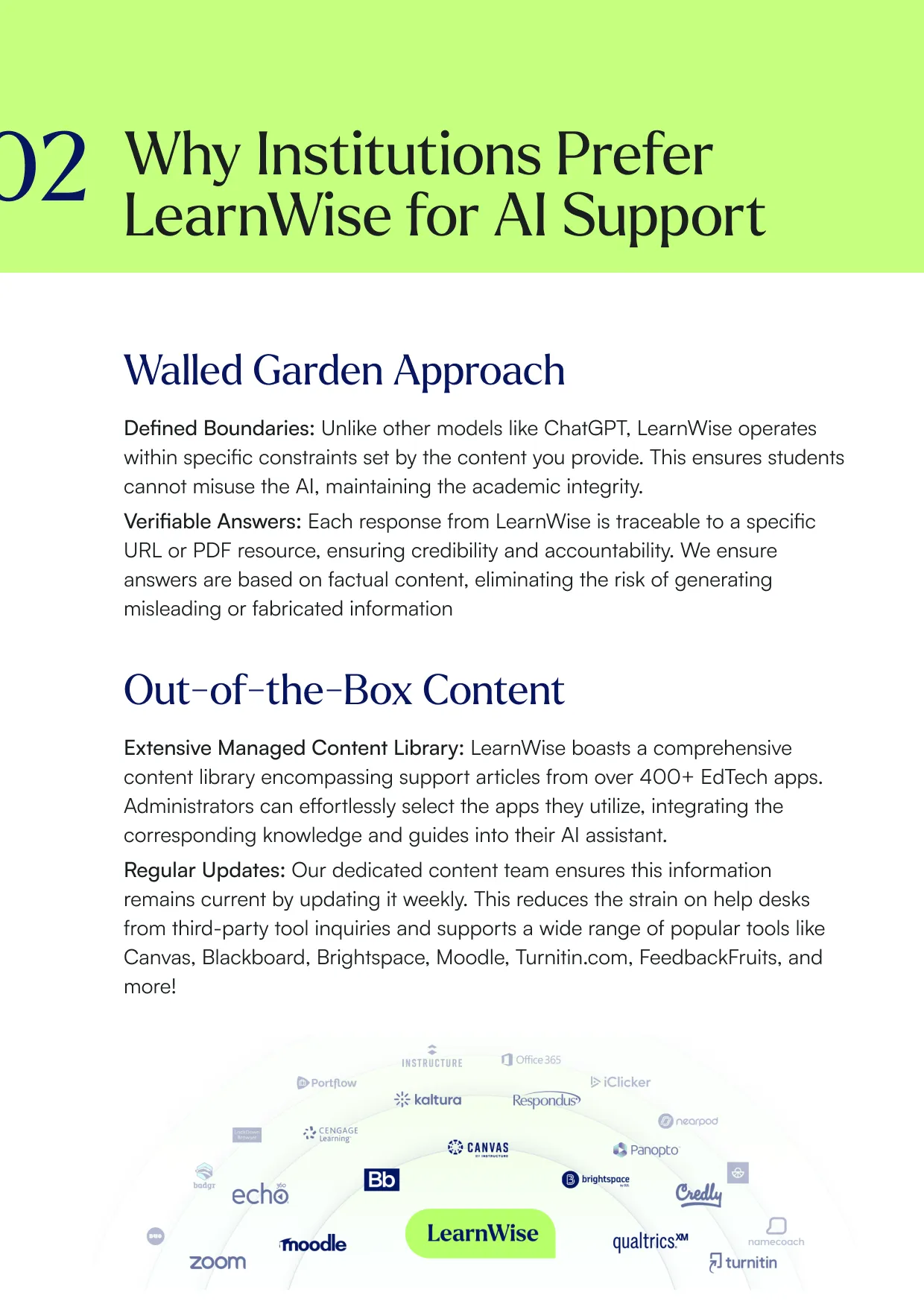
Télécharger le livre blanc


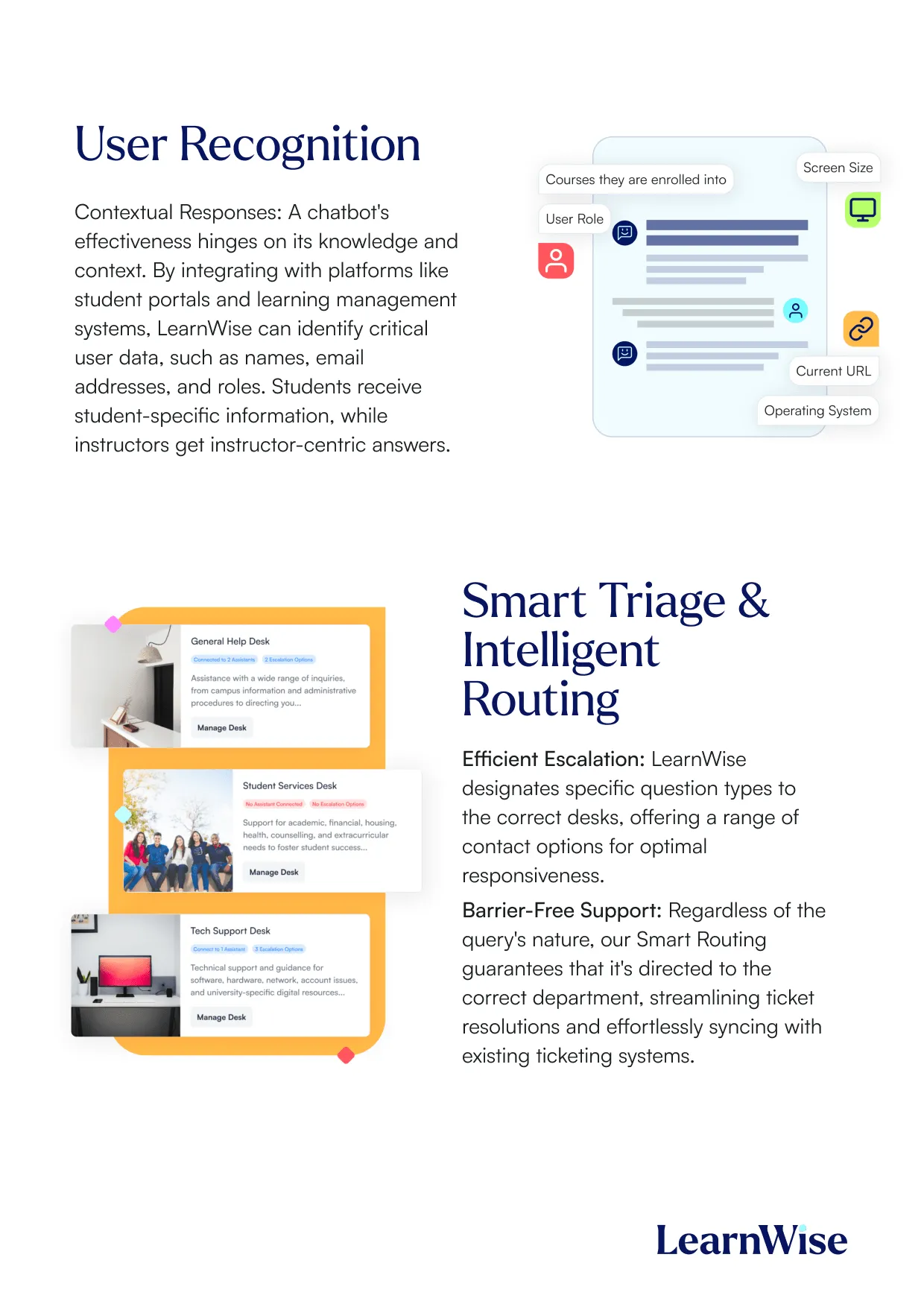

Chapter 4: How An AI Tutor Works With Your Course Content
Most AI tools fail to support real academic learning because they don’t speak the language of your course. They operate in isolation, detached from the syllabus, blind to assessment rubrics, and unaware of your institutional tone or policy. The result? Mismatched answers, hallucinated content, and frustrated users.
Tutor solutions such as LearnWise’s AI Tutor solves these challenges ingesting information with a walled-garden data approach: the AI system only uses information approved by the institution, allowing it to provide accurate information every time. In turn, the AI Tutor will only use course content that is relevant, timely and accurate for students. The result: a secure, scalable way to ground AI tutoring in the actual materials that make up course curriculums, and maintain high security standards.
This chapter explains how LearnWise connects to institutional content, and why that connection matters.
From Course Materials to Context-Aware AI
LearnWise uses a retrieval-augmented generation (RAG) approach to AI. This means it doesn’t generate answers from scratch or open-web knowledge. Instead, it:
- Ingests institutional content (course pages, PDFs, LMS objects, policies)
- Retrieves the most relevant snippets in real time, based on student or faculty queries
- Generates responses using only that verified content, with citations and transparency
Unlike other AI-powered quiz tools and learning solutions in the market, the AI Tutor ensures the material learners use to practice and revise for their exams is always factually accurate, relevant, aligned to academic expectations, and immediately actionable.
What Content Sources Can Be Ingested?
LearnWise supports ingestion from nearly every system where teaching and learning content lives:

All content is stored securely and processed according to your institution’s data privacy policies.
LearnWise is ISO 27001 certified and GDPR/FERPA-aligned. All ingestion is opt-in, and visibility rules can be configured by role or course.
Why Course-Aware Grounding Matters
Here’s the difference that course-aware grounding makes:
Without Grounding
“Hallucinated” facts from the open web
Misinterprets assignment questions
Generic feedback with no relevance
Vague help with deadlines or policies
With LearnWise
Answers pulled directly from your syllabus
References exact language in rubric
Tailored suggestions based on uploaded student work
Real answers using course-specific instructions
Students receive help that respects instructor intent. Faculty retain control over what AI can “see” and how it responds. And admins can monitor all interactions for alignment, coverage, and improvement opportunities.
How It Works: Behind the Scenes
Here’s a simplified version of the LearnWise RAG pipeline:
- Content is indexed by course or functional area (e.g., “Psych 101,” “Financial Aid,” “Library Services”)
- Queries from users are interpreted via role-aware intent parsing
- Relevant content is fetched based on metadata, tags, and similarity scores
- A final, fluent response is generated with a footnoted source trail
- Admin dashboards log the interaction, flag unusual behavior, and refresh stale knowledge areas
This system ensures that AI doesn’t invent answers, and faculty can trace every suggestion back to its source.
Faculty Controls for Content Use
Instructors and program teams can:
- Select which course items are available to the tutor
- Flag “sensitive” or draft material to exclude
- Add custom explanations, tone guidance, or preferred examples
- Schedule updates (e.g., refresh readings weekly)
LearnWise puts faculty in the driver’s seat with opt-in defaults and editable metadata settings.
Multilingual and Multimodal Compatibility
Courses that include:
- International cohorts
- Multiple content formats
- Open educational resources (OER), are all fully supported. LearnWise indexes multilingual inputs and allows students to query in their preferred language (e.g., “Explain this concept in Dutch” or “Summarize the video in Spanish”).
Institutions with bilingual mandates (e.g., Welsh-English, French-Dutch) have full support for dual-language delivery and tagging.
Final Takeaway
AI tutoring that’s not grounded in real course content is risky, inaccurate, and disconnected from learning outcomes.
With LearnWise, AI becomes a trusted, course-aligned layer, supporting students where they’re struggling, reinforcing institutional language, and empowering instructors to maintain academic integrity.
Chapter 5: Use Cases by Role: Student, Instructor, Advisor
AI adoption in higher education often fails because it’s approached with a one-size-fits-all mentality. But the reality is: students, faculty, and staff all engage with learning differently, and need different types of AI support.
This is why role-aware design is essential when building AI tools for education. Every interaction is shaped by who the user is, what permissions they have, and what their goals are in the learning environment.
This chapter explores what AI tutoring looks like through the lens of real institutional roles, and how LearnWise adapts to serve each one effectively.
Students: Building Academic Confidence
Students are the most frequent users of AI tutors, but they’re also the most vulnerable to misinformation, overreliance, or unintended bias from generic AI tools. That’s why LearnWise ensures every student-facing feature is:
- Grounded in their actual courses
- Transparent about sources and limits
- Opt-in and customizable by institution or instructor
Common Student Use Cases:
- “What does this assignment mean by ‘analytical lens’?”
- “Build me a study plan for next week with 2 hours/day.”
- “Turn this textbook chapter into flashcards.”
- “Explain the lecture slide on metabolic pathways in simpler terms.”
- “Summarize this week’s readings for quick review.”
As a result, students engaging with the AI Tutor can feel more confident in their study programs, feel less confusion about course materials, increase their engagement with the program, rely less on unvetted public tools (e.g. ChatGPT and beyond), and feel more confident in asking questions.
INSTRUCTORS: Course Content Improvement
Faculty are often skeptical of AI, and rightly so. Many tools claim to “save time” but actually create more friction or require instructors to change how they teach.
LearnWise is designed to fit inside existing workflows in the LMS, offering course content insights that allow instructors to view where students are struggling most. The opportunity to review the AI Tutor usage data is invaluable: it helps teachers save time by quickly pinpointing where students are often stuck or confused, what parts of the course might feel difficult, or where knowledge gaps are causing lower student engagement.
Armed with these insights, instructors can make use of the AI Tutor as a tool to assist them in building better course materials, fitted to support their students’ learning journeys at their time of need.
Common Instructor Use Cases:
- Leverage AI algorithms to provide students with personalized recommendations, like lesson plans, time management advice, and more.
- Integrate existing course materials and automate content updates to help students where they’re at in their learning journeys.
- Draft new course materials to fill knowledge gaps.
LearnWise’s Role-Aware Architecture
LearnWise doesn’t just “check boxes” for RBAC (Role-Based Access Control). It allows you to:
- Define new user roles (e.g., Graduate Teaching Assistants, Peer Mentors)
- Set different prompt behaviors per course or department
- Customize what data is logged, surfaced, or restricted by role
- Align visibility rules with internal policy and local regulations
This is what makes LearnWise enterprise-ready, and why institutions trust it to scale across departments and countries.
Chapter 6: Ethical AI Tutoring - Guardrails, Governance, and Opt-In Design
AI may be accelerating, but trust still moves at the speed of governance.
In higher education, where institutional values, academic integrity, and data protection are non-negotiable, AI tutoring must be governed as intentionally as it is deployed.
LearnWise is built with this principle at its core: no shortcuts, no surprises, and no one-size-fits-all governance. Institutions stay in control, faculty retain academic autonomy, and students understand how AI is used, because it’s transparent by design.
This chapter outlines how LearnWise supports ethical, scalable AI tutoring through layered guardrails, flexible governance tools, and opt-in implementation pathways.
Why Ethics Must Be Embedded, Not Tacked On
Many AI tools focus on novelty: what the technology can do. But in education, the more important question is: what should it do, and for whom, and when?
Without clear governance, institutions risk violating privacy standards (GDPR, FERPA), undermining academic integrity, losing faculty and student trust, or introducing bias or access inequity.
“Governance is not a gate. It’s the guardrail that keeps innovation aligned with mission.” — EDUCAUSE 2025 Horizon Report
Key Governance Features Built into LearnWise AI
LearnWise provides administrative, instructional, and technical teams with a comprehensive set of control points.
1. Role-Based Permissions
Define what each role can do with AI (view, interact, customize, override).
Example:
- Students can ask questions, but not edit prompts.
- Instructors can opt in/out by course or assignment.
- Advisors can monitor trends but not access student-level data.
2. Prompt Transparency and Versioning
Every prompt and system instruction can be:
- Previewed
- Edited (per course or global setting)
- Logged with version history
- Audited after the fact
This ensures instructors can align prompts with their pedagogy, and institutions can maintain accountability.
3. Institution-Governed Knowledge Sources
No public scraping. No uncontrolled hallucinations.
You choose what content the AI can access, including:
- Course content
- Institutional policies
- Support documentation
- Syllabi and rubrics
Each piece of content is tagged with metadata so the AI can cite and retrieve with accuracy.
4. Flagging and Feedback Systems
Both students and faculty can:
- Flag AI answers as unclear or inaccurate
- Request human review
- Suggest updates to content or prompt behavior
Admins can monitor these flags to drive quality improvement and policy updates.
5. Configurable Data Settings
- Control what data is stored and for how long
- Limit export scopes
- Restrict prompt logs to admins
- Integrate with institutional BI dashboards, not 3rd-party analytics tools
LearnWise is fully compliant with:
- ISO 27001
- GDPR
- FERPA
- SOC 2 Type II (where applicable)
Opt-In by Design
Too many tools in edtech assume consent. LearnWise doesn’t. Institutions can implement opt-in AI policies at multiple levels:
- Per course
- Per department or faculty
- Per assignment or module
- Per user (student or instructor)
LearnWise includes templates for syllabus language, student disclosures, and academic council approval pathways, so implementation is not only ethical, but also efficient.
Governance in Action: A Sample Rollout
Here’s how a mid-sized university governed its AI tutor launch using LearnWise:
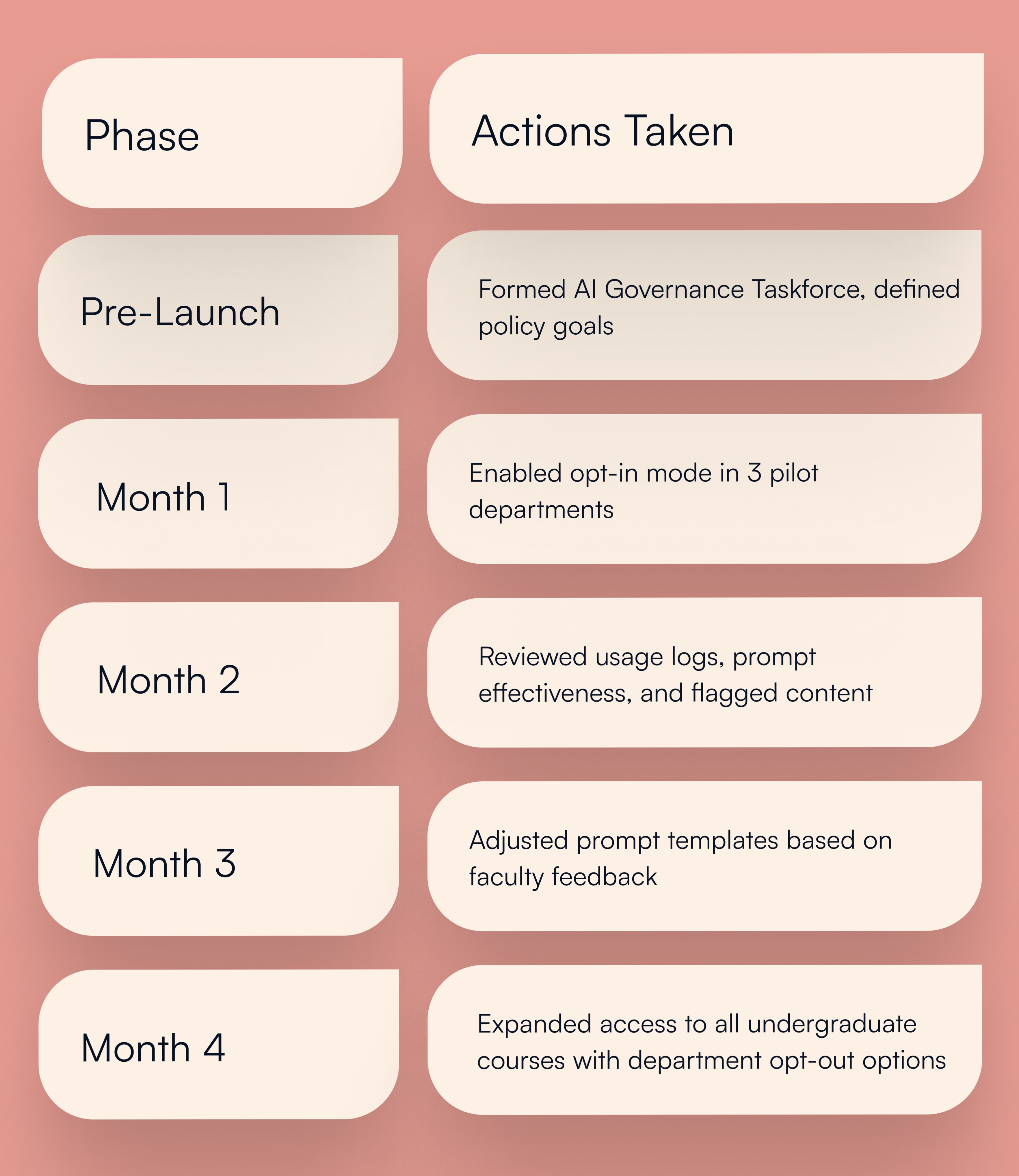
Final Takeaway
AI tools that lack governance aren’t just risky, but unscalable. To build trust with faculty, protect student agency, and maintain institutional integrity, your AI tutor must come with controls that match the complexity of your academic mission. LearnWise doesn’t just support ethics, it operationalizes it.
Télécharger l'étude



Télécharger le livre blanc




Chapter 7: Platform Comparison: LearnWise vs. ChatGPT, Khanmigo, and Mindgrasp
With dozens of AI tools entering the education market, it’s increasingly difficult for institutions to distinguish between solutions built for learners, and those built for the general public.
While tools like ChatGPT, Khanmigo, and Mindgrasp offer interesting capabilities, they are fundamentally not designed for institutional deployment at scale. Most lack LMS integration, academic governance controls, or context-awareness grounded in course content.
This chapter provides a side-by-side comparison between LearnWise and leading general-purpose or tutoring-focused AI tools, so your team can make a confident, informed decision.
Why Platform Fit Matters
Choosing an AI tutor isn’t about picking the “smartest” model, it’s about picking the platform that:
- Aligns with your LMS ecosystem
- Respects academic workflows
- Supports student agency and privacy
- Offers real-time, course-aware responses, not public data hallucinations
When institutions deploy the wrong tool:
- Faculty opt-out en masse
- Students get conflicting answers
- Governance becomes impossible
- Privacy and compliance are at risk
Remember: if the platform doesn’t support your LMS or give you prompt control, it’s not built for higher education. Below, a side-by-side comparison:
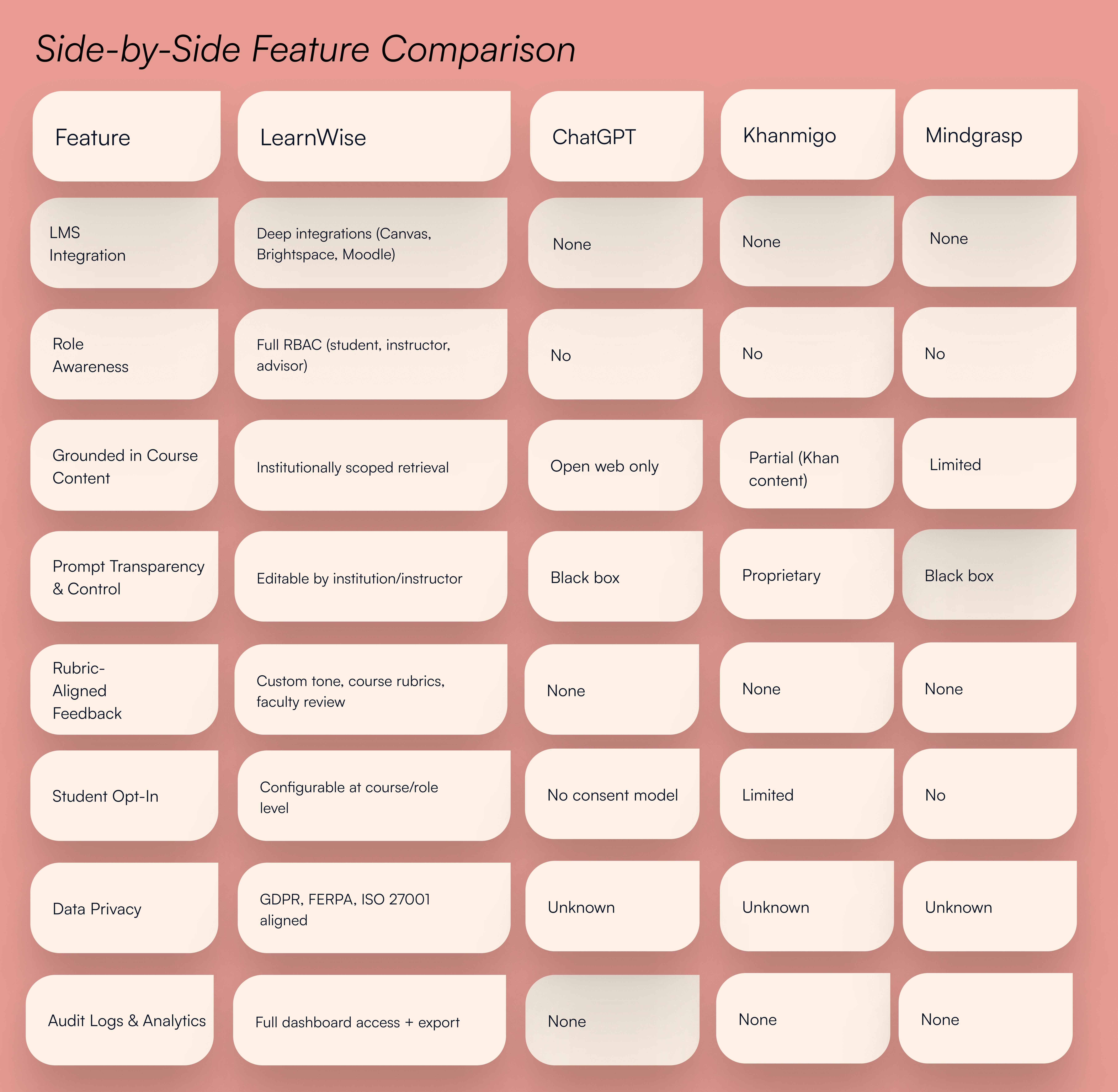
Highlights of Key Differentiators
LMS-Native vs. LMS-Adjacent
LearnWise is directly embedded into the LMS interface: no extra tabs, logins, or third-party tools. ChatGPT, Khanmigo, and Mindgrasp require students to leave their workflow.
Governance and Policy Fit
Only LearnWise supports institutional policy compliance, prompt auditing, student opt-in, and academic council sign-off.
Real Course Intelligence
LearnWise doesn’t hallucinate from open data. Its AI tutor is grounded in your uploaded course materials, institutional documents, and rubrics.
Instructor Alignment
Unlike consumer tools, LearnWise supports faculty with real-time data, surfacing knowledge gaps in the student learning journey and points of difficulty for optimized course material development.
Bottom Line: Institutional-Grade AI Requires More Than a Model
Generic AI tools may answer questions. But only a higher education-grade platform can:
- Serve different roles ethically
- Align to policy and pedagogy
- Reduce institutional risk
- Scale across programs, campuses, and languages
LearnWise was designed specifically for colleges and universities: not as a productivity plugin, but as an academic support engine.
Chapter 8: What to Ask Vendors Before You Pilot an AI Tutor
Choosing an AI tutor is a strategic decision, not just a product pick. With dozens of new vendors entering the education space, institutions need a clear, consistent framework to separate marketing claims from platform reality.
This chapter offers a practical set of questions your team can use to assess any AI tutoring platform, and determine whether it’s ready for production deployment in a university environment.
Whether you're drafting an RFP, evaluating pilots, or shortlisting tools, this checklist will keep your evaluation focused on impact, integrity, and institutional fit.
Integration & Platform Fit
- Does the AI tutor integrate natively with your LMS (Canvas, Brightspace, Moodle)?
- Or does it require tab-switching or browser extensions?
- Or does it require tab-switching or browser extensions?
- Can the tool ingest institutional content (syllabi, rubrics, videos)?
- If yes, what formats? What security protocols are in place?
- If yes, what formats? What security protocols are in place?
- Does the platform differentiate user roles (student vs. instructor vs. advisor)?
- Are there specific workflows per role?
- Are there specific workflows per role?
- What is the time-to-deploy?
- Ask for examples of implementation timelines and required IT support.
Data Privacy, Compliance & Security
- Is the platform compliant with GDPR, FERPA, ISO 27001, or SOC 2?
- Request documentation.
- Request documentation.
- How are student interactions logged, stored, or anonymized?
- Can your institution access logs for auditing?
- Can your institution access logs for auditing?
- Are third-party models or sub-processors used?
- Where is data stored? Can you control it?
- Where is data stored? Can you control it?
- Can students opt in/out?
- Does the platform support per-course or per-user consent?
- Does the platform support per-course or per-user consent?
Pedagogical Alignment
- Can instructors customize AI behavior (e.g., tone, prompt templates, examples)?
- Does the AI support rubric-aligned feedback and course-context tutoring?
- Can faculty monitor or review AI suggestions before they reach students?
- What training or onboarding is provided for instructors?
Governance & Analytics
- Can you edit, version, and audit system prompts?
- What dashboards are available for different roles?
- Ask to see examples for student success, T&L, and IT leaders.
- Can you export data to PowerBI, Tableau, or institutional BI platforms?
- Does the platform offer institutional partnerships or support councils?
Evidence & Evaluation
- Are there live deployments in higher education today?
- Can you speak to a reference customer using it inside their LMS?
- Can you request sandbox access for pilot teams?
- Does the vendor provide pilot success criteria or baseline KPIs?
RFP-Inclusive Language (for your procurement teams)
If you're issuing a Request for Proposal or Information (RFP/RFI), include language like:
- “The AI tutoring solution must operate within our LMS (Canvas/Brightspace/Moodle) without requiring student data to be exported to third-party tools.”
- “Preference will be given to platforms that support GDPR and FERPA compliance, provide prompt transparency, and offer multi-role dashboards.”
- “Solutions must support content ingestion from institutional sources and enable administrators to control knowledge scope and user permissions.”
- “Vendors should demonstrate impact across feedback time, Tier-1 ticket reduction, and learning support metrics within higher education settings.”
Choose a Tutor That Respects Your Ecosystem
An AI tutor is only as good as its:
- Intégration
- Ethics
- Governance
- Outcomes
If a vendor can’t answer these 20 questions, or hesitates to offer proof, they may not be ready for the rigor of higher education.
LearnWise is already deployed at universities across the UK and EU. We welcome deep evaluation, and we build our platform around the workflows, policies, and values of our institutional partners.
Book a walkthrough today → learnwise.ai/demo





.png)
%20(1).png)
%20(1).png)
